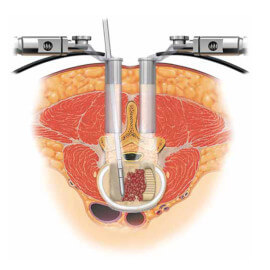Minimally Invasive Spine Surgery
Request Appointment
About Minimally Invasive Spine Surgery (MIS)
The term Minimally Invasive Spine Surgery (MIS) is used to describe a variety of surgical techniques where the incisions are smaller and the amount of tissue damage beneath the skin is reduced. In minimally invasive spine surgery, Dr. Jones-Quiadoo uses specially designed instruments that help him visualize the surgical field. Typically, this is done with tubular retractors that allow the surgeon to make a small incision but visualize a larger area beneath the small incision. Spine surgeons who perform minimally invasive spine surgery should be fully trained in the correct use of these techniques.

What Is the Future of Minimally Invasive Spine Surgery?
Newer areas for minimally invasive techniques include the fusion of two vertebrae together and expanding endoscopic procedures (meaning: the surgery is performed through little holes in the skin as opposed to a larger incision). The field of minimally invasive spine surgery is growing rapidly and the overall trend is toward more minimally invasive techniques and new procedures.
What Are the Potential Benefits of Minimally Invasive Spine Surgery?
The potential benefits of minimally invasive spine surgery may include smaller scars following the operation and less damage to the surrounding tissues beneath the skin, meaning less pain and blood loss. The potential outcomes of such operations are the reduction of pain and morbidity associated with standard open surgery. At the moment there is insufficient data to show that minimally invasive spine surgery provides any short and long term benefit to patients when compared to traditional spine surgery.
